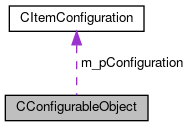#include <CConfigurableObject.h>

Public Member Functions | |
| CConfigurableObject (const CConfigurableObject &rhs) | |
| CConfigurableObject & | operator= (const CConfigurableObject &rsh) |
| int | operator== (const CConfigurableObject &rhs) const |
| int | operator!= (const CConfigurableObject &rhs) const |
| void | Attach (CItemConfiguration *pConfiguration, bool dynamic=true) |
| void | configure (std::string name, std::string value) |
| std::string | getName () const |
| std::string | cget (std::string name) |
| CItemConfiguration::ConfigurationArray | cget () |
| virtual void | onAttach ()=0 |
Protected Attributes | |
| CItemConfiguration * | m_pConfiguration |
Detailed Description
This is the base class for an item that has a configuration. Normally this has to be extended tremendously to be usable as e.g. a readout module.
The class contains as a protected member, an object of type CItemConfiguration* At construction time, this is NULL. It is attached via the Attach member function, whic is virtual, and invokes the pure virtual onAttach member function to allow concrete classes to setup the configuration keywords supported.
Copy construction is supported and results in a copy of the item configuration itself.
The CItemConfiguration member functions:
- getName
- cget
- configure
- clearConfiguration
are facaded through this base class so that configurable objects can be configured and inquired by script level beasts that only need to manipulate configurations.
Constructor & Destructor Documentation
◆ CConfigurableObject()
| CConfigurableObject::CConfigurableObject | ( | const CConfigurableObject & | rhs | ) |
Copy construction.
Member Function Documentation
◆ Attach()
| void CConfigurableObject::Attach | ( | CItemConfiguration * | pConfiguration, |
| bool | dynamic = true |
||
| ) |
Once constructed, at some point the oustide world attaches a configuration to the object. This does that and then invokes the onAttach member function which provides concrete subclasses the chance to create the configuration parameters.
- Parameters
-
pConfiguration - Pointer to the configuration to attach. dynamic - If true, pConfiguration point to a dynamcially allocated object that should be deleted in our destructors.
- Note
- - no assumption is made about only attaching once.
◆ cget() [1/2]
| std::string CConfigurableObject::cget | ( | std::string | name | ) |
- Parameters
-
name - Name of a configuration parameteter.
- Returns
- string
- Return values
-
Value of that parameter.
- Exceptions
-
CInvalidArgumentException string - message if the parameter name does not exist.
◆ cget() [2/2]
| CItemConfiguration::ConfigurationArray CConfigurableObject::cget | ( | ) |
- Returns
- CItemConfiguration::ConfigurationArray
- Return values
-
the entire configuration for this module.
- Exceptions
-
CInvalidArgumentException if no configuration.
◆ configure()
| void CConfigurableObject::configure | ( | std::string | name, |
| std::string | value | ||
| ) |
Configure the value of the defined parameter. This can throw for the following reasons;
- The delegated function throws,
- m_pConfiguration is null.
◆ getName()
| std::string CConfigurableObject::getName | ( | ) | const |
Get the name of the configuration item which is usually the name of the object.
- Returns
- std::string
- Return values
-
Name of the configuration.
◆ operator!=()
| int CConfigurableObject::operator!= | ( | const CConfigurableObject & | rhs | ) | const |
Inequality is simpler.. just negate equality compare:
◆ operator=()
| CConfigurableObject & CConfigurableObject::operator= | ( | const CConfigurableObject & | rhs | ) |
Objects assign much like a copy construction, however the old configuration may need to be deleted.
◆ operator==()
| int CConfigurableObject::operator== | ( | const CConfigurableObject & | rhs | ) | const |
Equality means the configuration is identical:
The documentation for this class was generated from the following files:
- libtclplus/include/tclplus/CConfigurableObject.h
- libtclplus/tclplus/CConfigurableObject.cpp
 1.8.13
1.8.13